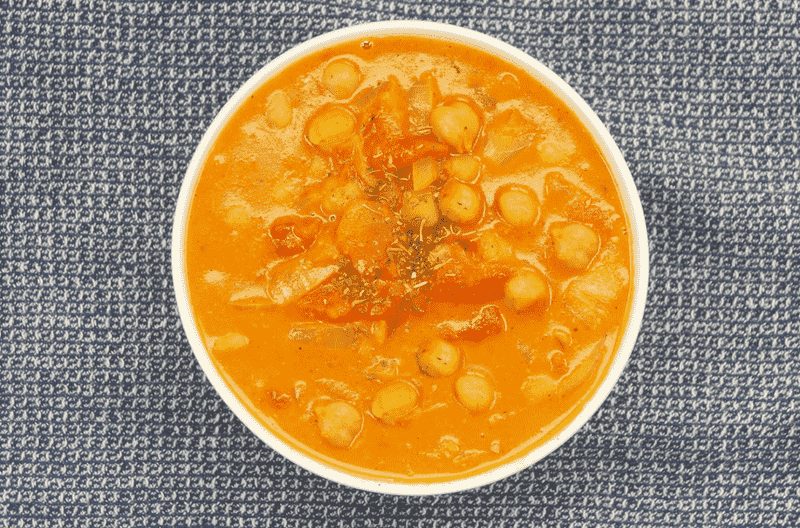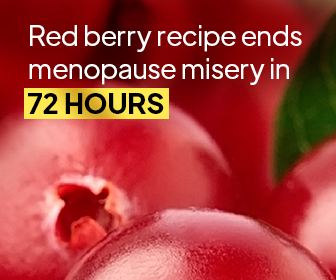Are dinner times getting a little boring in your family home? If you’re tired of making the same old recipes over and over again, it could be time to shake things up a little. There’s nothing quite as satisfying as a temptingly rich vegan chickpea curry. Adding this to your mealtime rotation means that you and your kids can try something new.
Of course, getting children to try something new can often be a difficult feat. However, this mild and subtle coconut curry is a great way to introduce them to Asian cuisine. What’s more, as an added bonus, this thai vegetable curry recipe is 100% vegan. That means that you can feel awesome about feeding the whole family a healthy yet flavorsome dinner. Here’s the easy recipe and why you have to give it a go.
A Short Introduction to Curry
If you’re completely new to the world of curries, you’ve come to the right place. It can all seem a little daunting when you first start out. Contrary to popular belief, curry doesn’t refer to just one dish from just one place. Think of the word as more of an umbrella term for a whole host of recipes around Asia. Still feeling a little bamboozled? Here’s a rundown of the main characteristics of three different styles of curry.
Thai curry
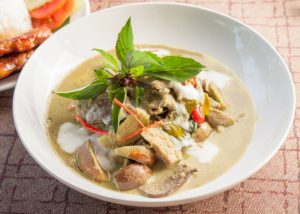
Famous for its sweet and balanced flavors, Thai curry is a real winner. This type of dish often uses a combination of curry paste, coconut milk, and vegetables to gain its original flavor. You may have heard of the spicy Thai green curry, but there’s a lot more to explore. Thai vegetable curry, yellow curry, and red curry all have rich, tantalizing flavors!
Indian curry
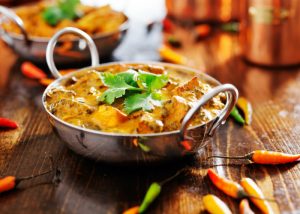
It’s important to note that the types of Indian curry vary a great deal from region to region. With that in mind, let’s focus on the most common dishes that you will find in restaurants and cookery books. An easy recipe to start with would be a chicken tikka masala which, while not massively traditional, has become wildly popular.
Curries often have a rich, tomato base and a combination of tempting flavors including turmeric, garlic, ginger, ghee, cilantro, and chili. Another popular dish is a biryani, the base of which is actually rice making for a drier meal. This cuisine is as rich as it diverse which means there’s a lot to research here.
Japanese curry
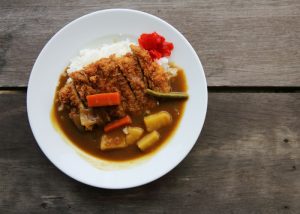
When you think of Japanese cuisine, you may think of sushi before curry. However, it could surprise you to find out that curry (or kare) is quite common in this cuisine. If you order this dish in a restaurant, you’re most likely to see a sauce which consists of honey, soy sauce, carrots, chicken stock, curry powder, garlic and onions. It’s a warming and balanced flavor that doesn’t pack much spice.
Choosing the Best Curry Ingredients
New to the world of curry ingredients? Don’t let all the exotic names baffle you. These days, getting herbs, spices, and whole food ingredients couldn’t be easier. Many grocery stores now have specialist food sections where you can find some exotic curry ingredients.
Failing that, you could also try heading to a world food store or even ordering your spices online. Here are a few things to keep in mind when selecting your curry ingredients.
Spice of life
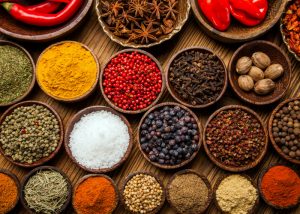
The best way to get the finest spices for your vegan curry recipe is to do your research. Make sure that you’re looking for the exact powders that you need when you go to the store or start shopping online.
You should also keep in mind that bulk-buying will save you money in the long run. If you’re going to make a lot of curries in the future, buy big batches now. Investing in a large tub of turmeric is certain to be cheaper by ounce than a small one. Here are some of the spices that you will find in typical curry dishes:
- Garam masala – This blend of spices actually encompasses many of the flavors that you might want in your standard curry. Each blend could vary but you will usually find turmeric, mustard seeds, and garlic powder.
- Turmeric – Known for its striking yellow color, turmeric is one of the most common curry ingredients. While it doesn’t add a big kick of flavor, it gives the dish a wonderfully bright tone and helps to blend the rest of the spices.
- Cumin – Warm and tempting, you can’t go wrong with a dash of cumin. This powder is actually a ground seed which is common in the Middle East and India. Don’t use too much of the spice though, as it can have a bitter aftertaste.
- Chili powder – This is one of the curry ingredients that you might want to use sparingly. Just a sprinkle of this ground chili powder should be enough to give your dish a level of heat that you can handle.
- Mustard seeds – In many curries, it’s traditional to start the dish by popping some mustard seeds in some hot oil (or ghee). Opt for black seeds rather than yellow ones as they have a stronger, spicier flavor.
- Curry powder – As you might imagine, there’s no spice called curry powder. However, this ingredient is usually a mix of a whole range of different spices. You will often find that it includes many of the spices listed above. Use it for a balanced taste combination.
Fresh is best
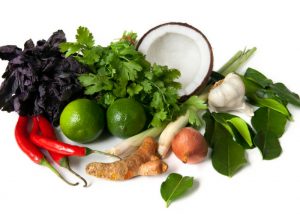
When it comes to curry ingredients such as cilantro, ginger, garlic, and lemons, there’s one golden rule you need to know. Fresh is best. Head to the store the day you’re planning to make your curry and stock up on these things. While you can get garlic and ginger powders, you should choose the real deal.
Frozen is a backup
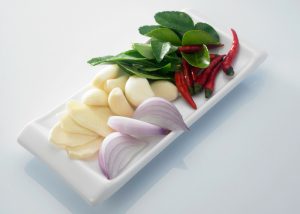
Short on time? There are instances when using some frozen alternatives for your curry ingredients will do the trick. You can get frozen chopped onions, grated ginger, and even garlic puree. While these options may not taste as fresh as they could, having them in your freezer means you can make a vegan curry at a moment’s notice.
What Are the Benefits of Curry?
The warming, enticing scents of curry are often too hard to resist. But could this comfort food actually be good for your health as well? If you’re thinking of serving up a family meal of vegan chickpea curry, it may surprise you to find that it’s brimming with health benefits. Here are some of the benefits of this kind of Thai vegetable curry.
Antibacterial properties
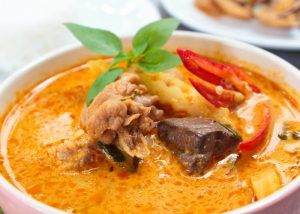
One of the most common curry ingredients is the humble cilantro. This herb might not seem all that exciting but it could fight off bacteria in your body. Scientists recommend using cilantro oil to fight off diseases and food poisoning in hospitals.[1] Adding some fresh ground cilantro to your dish could help you reap the benefits of curry.
Antioxidizing powers
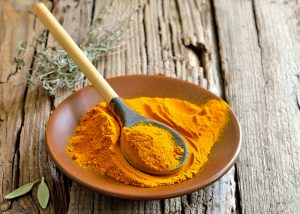
Most standard curry recipe guides (including this one) list turmeric as a key ingredient. This yellow powder could be more powerful than you realize. The spice has a yellow pigment called curcumin inside it, which is a serious antioxidant. Research has suggested that it also has anti-inflammatory properties which play a role in preventing some of the world’s most dangerous diseases and health conditions.[2]
Boost mood and memory
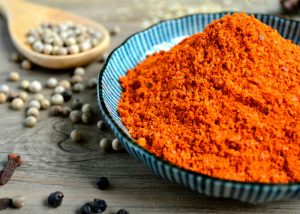
The same pigment, curcumin, which is a major part of turmeric may have other health benefits. One study from the University of California, Los Angeles found that consuming this antioxidant could halt age-related memory loss as well as improving mood.[3] While the experts don’t currently know the exact reason for this effect, it’s fair to say that it’s one of the most impressive benefits of curry.
Cancer prevention
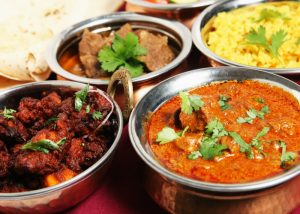
As though that weren’t enough to have you reaching for your tub of turmeric powder, this is one of those curry ingredients with even more exciting qualities. One study suggests that the spice could prevent head and neck cancer by stopping cancerous cells from growing.[4] Of course, the scientists need more information to prove this theory conclusively, but it is certainly an interesting idea and another reason to give this Thai vegetable curry a try!
Healthy yet tasty
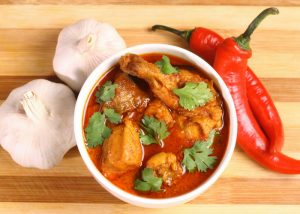
Trying to get your children to eat their greens can feel like an impossible task. One of the great benefits of curry is that its rich flavors make vegetables taste good! Cooking up healthy vegetables in a coconut curry is a sure-fire way to change their minds about greens. The genius thing about this type of curry recipe is the fact that you can customize it and really make it your own. If there’s a vegetable you know that your little ones love, go ahead and throw it into the mix.
Vegan Chickpea Curry Recipe
If you’re looking for a super easy, healthy weeknight meal, look no further. This vegan chickpea curry takes less than an hour to cook and is sure to be a real hit with the entire family. Should you be cooking for your children, be aware of their tastes. This standard recipe is relatively mild. However, if they have never had curry before, you could leave out the curry powder and focus on the other spices.
Perfecting your curry seasoning game is all about finding the right balance.
In order to get the right balance of flavors, you absolutely must make sure that you try this vegan chickpea curry recipe regularly while cooking. Doing so will mean that you can create a spectacular dish that is as delicious as it is brimming with healthful ingredients. Enjoy!
Prep time: 5 minutes | Cook time: 50 minutes | Total time: 55 minutes
Serves: 4 | Equipment: Large pan
Ingredients
- 2 chopped onions
- 3 chopped cloves of garlic
- 1 Tbsp crushed ginger
- 1 Tbsp garam masala
- 400g drained chickpeas
- 400ml coconut milk
- 1 Tbsp ground coriander
- 400g canned tomatoes
- 1 Tbsp ground black pepper
- 1 Tbsp curry powder
- Coconut oil
Instructions
- In a large pan, begin by heating up the coconut oil over medium heat. Next, add the garlic and onions to the oil and cook for around 5-10 minutes.
- When the onions are soft, add the ginger, garam masala, ground coriander, black pepper, and curry powder. Cook on a low heat for a few minutes.
- Add the canned tomatoes to the pan and cook on a medium heat for 5 minutes.
- After 5 minutes try the mixture to test if it is spicy enough for you. Add more spices if needed to add more heat and flavor, and cook for another 5 minutes.
- Finally, add the drained chickpeas and coconut milk to the curry sauce, bring to boil and then simmer for a further 5 minutes.
Optional extras
- Lemon juice
- Chopped cilantro
- Basmati rice/quinoa
- When the curry is finished, leave it to simmer on a low heat for a further 20-30 minutes. This will help to really lock in the flavors!
- Use this time to cook your carbs. Opt for either the tasty pseudo-grain that is quinoa or the classic curry accompaniment, basmati rice. The choice is yours.
- For a fresh taste, add a squeeze of lemon and some finely chopped cilantro to the curry before serving.
Customize Your Chickpea Curry Recipe
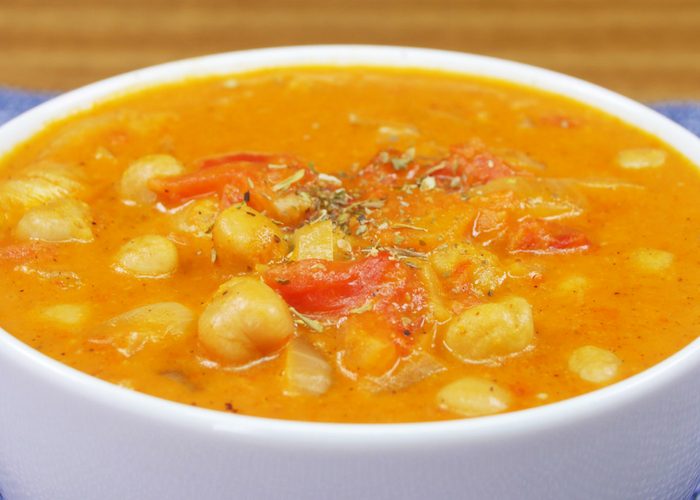
While you can use this recipe as a base, there’s no reason you can’t customize it to suit your needs. Children can be fussy at the best of times. If your little ones (or you) don’t like something, making a few changes could not be easier. Here are a few ideas that will help you create a vegan chickpea curry that suits you.
- Add some sweet potatoes
Need to bulk-out your dish? You don’t need to grab another tin of chickpeas. Instead, chop up some sweet potatoes and boil the pieces. Add them to the curry for a sweet and delightful addition to the dish. - Swap the onions for peppers
Not too keen on onions? No problem. You can quickly and easily swap the chopped onions for some red peppers instead. Make sure that they are thinly sliced for the best results. You might also want to give them a little longer to cook in the pan. - Ditch the curry powder
If your kids have never tried curry before, even the tiniest bit of curry powder may be too much for them to handle. The other flavors – the turmeric, ginger, garlic etc. – will be enough to make a mouth-wateringly good vegan chickpea curry. - Get a little zesty!
Want to add something a little special to the mix before serving? Zest a lemon and garnish the curry with some of the peel. The little pieces will give the curry a blast of unexpected flavor that everyone will adore.
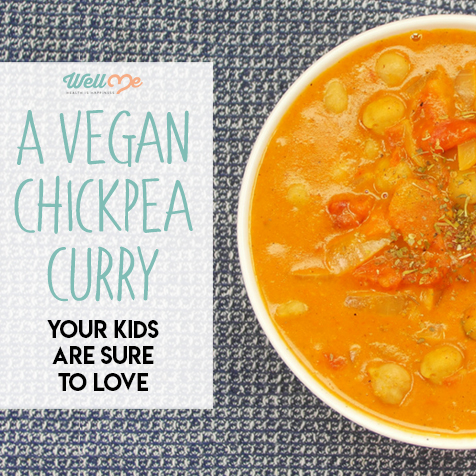
Try this Vegan Curry Recipe Today!
So, what are you waiting for? Now that you’ve got the details of how to spice things up – literally – it’s time to make your own vegan chickpea curry. Follow the standard recipe first. Once you’ve got that perfected, try mixing things up and making your own version of this vegan curry. Happy cooking!

